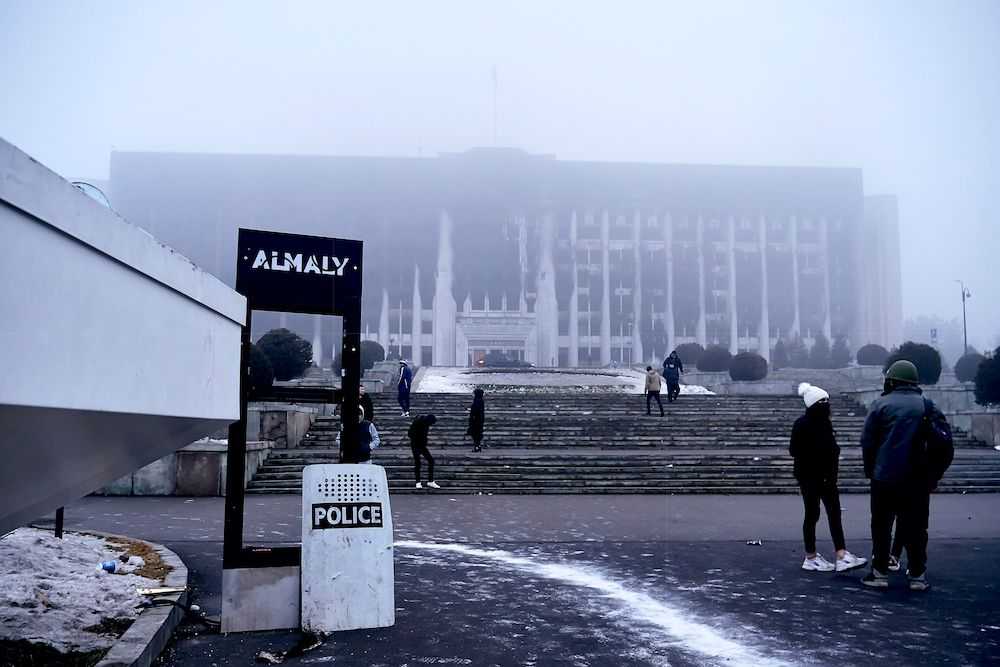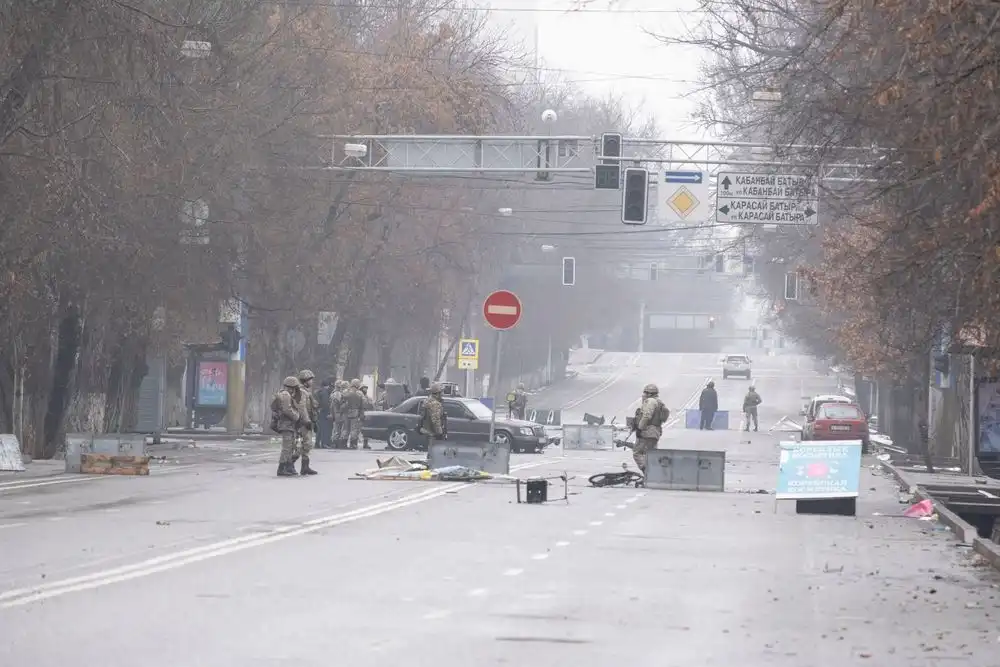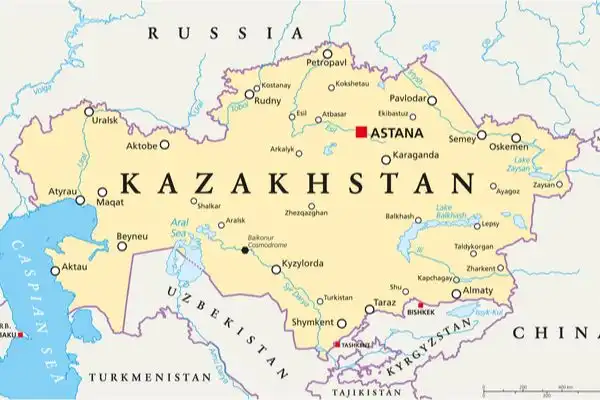Home>Popular Protests in Kazakhstan: A New Victory for Putin's Political Agenda?

03.02.2022
Popular Protests in Kazakhstan: A New Victory for Putin's Political Agenda?
By Bayram Balci
2022 began with an unprecedented popular uprising in Kazakhstan which recently celebrated 30 years since leaving the Soviet Union. On 2 January, hundreds, if not thousands, of residents in the oil and gas producing industrial city of Janaozen rioted after the government announced a sharp increase in the price of LPG fuel, the most used fuel in the country. The protest quickly spread to the rest of the country, taking more political, but also violent, forms, especially in the region of Almaty, capital city of Kazakhstan until 1997 and still the main commercial and cultural hub.
Overwhelmed by the events and caught in a panic, the government shifted to a more repressive attitude. Unsure of being able to control the situation, Kasim-Jomart Tokayev’s government had no choice but to call on Russia to intervene within the framework of the Collective Security Treaty Organisation (CTSO), of which several former USSR countries are members.
This economic and political protest and the way it was handled will have major implications for the future of Kazakhstan, for the countries of the region and, of course, for Russia, which is reminding everyone that it is still a force to be reckoned with in Kazakhstan and in the entire post-Soviet space.
The economic protest awakened the existing divisions between the clans in power
The protest started in the west of the country, in the town of Janaozen, a working-class city in a region whose wealth in gas and oil makes Kazakhstan one of the richest oil states in the world. But this wealth is relative, as it only benefits the ruling class and their relatives to the detriment of a population that has been waiting for decades for economic reforms that are slow in coming. This poor distribution of wealth, added to the high inflation rate that the country is currently experiencing and the impoverishment of a large part of the population, in a pandemic context clearly mismanaged by the authorities, has provoked the sudden revolt of the population of a country portrayed by the international media as a model of stability. However, as is often the case, an economic revolt conceals social and political frustration that comes to light during crises such as the one Kazakhstan has just experienced.
What has been difficult to explain is why the initially peaceful protest in the West took a very violent turn in the South, especially in the Almaty region, historically more conservative and Kazakh than the North which is closer to the Russian border and therefore more Russian-speaking. Peaceful demonstrators demanding more justice and economic equality were in fact joined by gangs of thugs, clearly following an organised crime logic, who attacked and looted several shopping centres, shops and cash machines. Public buildings were stormed and the city’s airport was occupied by demonstrators for a few hours. Two weeks after the events, it is easier to understand the meaning of and reasons for the violence, which became so widespread that the authorities, overwhelmed, resorted to force and appealed to Russia in order not to lose control of the situation and let the country sink into civil war. The reasons behind the use of repression and the appeal for Russian help are to be found in the power structure in Kazakhstan.
The power structure in Kazakhstan
The particularity of power in Kazakhstan, apart from its clan aspect, is that it has been a diarchy for several years. Leader and absolute master of the country since the end of the USSR, Nursultan Nazarbayev, as an enlightened man as he was often presented, Nursultan Nazarbayev, leader and absolute master of the country since the end of the USSR and presented by some as an enlightened man, supposedly handed over power in 2019 to his close political ally, Kassym-Jomart Tokayev. In reality his departure from power had been only symbolic, for as the Elbasi—the Father of the Nation—head of the National Security Council, he continued to hold the most power. More importantly, and this is crucial to understanding the events, the clans that support Nursultan Nazarbayev organised the most violent actions as they feared that when Kassym-Jomart Tokayev began to take measures (such as the moratorium on the increase in fuel prices or the dismissal of certain state officials close to President Nazarbayev) to calm the situation down they would lose privileges. It was these clans in particular that used organised criminal groups to ransack many businesses and official buildings in Almaty and its region. Frightened by the scale and the violence of the protest, Tokayev’s government took concrete political measures with serious consequences. These actions in fact resembled a coup, or a “colour revolution” as it is called in the countries of the former USSR, i.e. getting rid of the government and replacing it with another. This is indeed what happened. Strengthened by the protests, and no doubt happy to finally be alone at the head of the state, Tokayev definitively ousted the country’s true master, Nursultan Nazarbayev.
Nazarbayev was removed from his position as chairman of the National Security Council, which is now controlled by Tokayev. Moreover, to avoid any resistance from the Nazarbayev clan within the state, Karim Masimov, a key man of the former system who headed the powerful intelligence services, was removed from his post and is now in prison for high treason.
What we have just witnessed is a real change of power, a sort of palace revolution. But, more importantly, this change of power has been accompanied by another major fact during the crisis: the attitude of Russia, which took a number of specific steps with grave repercussions for the future. Indeed, as soon as Tokayev’s government reached out for help, Russia found the necessary justification to deploy more than 2,000 CSTO soldiers, the majority of whom were Russian. Russia thus made it clear to everyone that what was happening in this part of its own backyard, its “near abroad”, concerned it to the utmost.

Regional consequences
A country that used to have a reputation for stability, prosperity and a leader that some deemed enlightened and visionary, Kazakhstan is now reeling from a crisis with the after effects still to come. Now alone without his mentor at the helm, Tokayev will have to take the necessary action to meet increasingly urgent social demands. The standard of living of the population is not worthy of the country’s economic wealth, or at least far below that of the ruling elite and their extended families. If social and economic justice is not brought about, the next protest may well be more explosive, with the risk of aggravating the many cleavages the country is experiencing. Indeed, although not always visible, there are deep divisions in the country. Three “jouzes”, tribal confederations themselves divided into various clans, make up the country's population. Moreover, the north is more Russianised than the more Kazakh and conservative south. In addition to Russians and Kazakhs, other ethnic groups live in the Almaty and Chymkent region, which is more populated than the rest of Kazakhstan.
In terms of foreign policy, the fact that the country has turned to Russia signals the failure of Nazarbayev’s multi-pronged policy. Indeed, Nazarbayev, together with his former foreign minister Tokayev, boasted of having built a strong state, an emerging Eurasian power, a partner of several countries between Asia and Europe, capable of having balanced and stable relationships with Russia. However, the wavering government was saved by Russia, without the help of another partner in this multi-faceted arrangement. A new era is therefore opening up in the foreign policy of the country, which will have to reaffirm its rank on a regional scene still dominated by Russia.
For the other Central Asian countries, which have certainly been watching the recent events in Kazakhstan with some anxiety, there are lessons to be learned. For in these countries similar inequalities can be observed, especially in Turkmenistan, which is also an oil and gas-producing state. Failure to meet the demands of the population could lead to similar explosions. The same could be said for less energy-rich countries such as Uzbekistan and Tajikistan, as well as Kyrgyzstan, which has already experienced insurgencies similar to that in Kazakhstan…
The role of the Collective Security Treaty Organisation (CSTO), through an unprecedented intervention
In terms of international politics, the consequences of this recent crisis will be no less important. The fact that the government felt the need to call on Russia, via the Collective Security Treaty Organisation (CSTO), risks provoking a reshuffling of the cards in the region, in addition to reminding us that Moscow is still calls the shots in the region.
As a collective security organisation and as a military alliance designed to protect member countries against external threats, the CSTO resembles the Warsaw Pact agreement that united the USSR and Eastern bloc countries during the Cold War. The Organisation seems to have been deployed for the first time in its history for a purpose that is not among its founding principles. Indeed, the soldiers, mostly Russian but also Armenian, Belarusian, Tajik and Kyrgyz, came to Kazakhstan to defend it against an insurgency from within, rather than from an external aggression, as stated in principle in the CSTO’s rules. In other words, the CSTO was used as a police force, to save the regime of a member country of the alliance. Previously, Armenia, which had asked for CSTO help in dealing with Azerbaijan, had been turned down even when Azeri forces had entered Armenian territory, i.e. outside Nagorno-Karabakh. And in June 2010, when the Kyrgyz provisional government of Roza Otunbayeva asked for help to put an end to the inter-ethnic fighting in the city of Osh, the leadership of the CSTO considered that this did not fall within its remit.
This time, however, Russia—the alliance’s main military force—responded positively to Tokayev’s appeal. Putin was able to deploy more than 2,000 CSTO soldiers quickly and effectively, in fact saving the country from chaos. This reading and application of the CSTO charter may have several consequences for the alliance. Either it will be discredited in the years to come, because it has just shown that it is acting to save a beleaguered regime that is friendly to Russia. Or, on the other hand, it may actually show its usefulness to the member countries, which will then use it as a law enforcement force when the country’s own army, police and intelligence services no longer inspire confidence and do not help the regime to deal with internal threats. At the same time, in the eyes of public opinion in Central Asian countries, where Russia is still seen as a neo-colonial power, the CSTO could be seen as a Russian “instrument” that perpetuates social injustices in these countries.
If there is one single lesson to be learned from this Kazakh crisis that was brought under control with Russia’s help, it is that Russia is still the absolute and inescapable master of the region. The entire discourse of multi-faceted foreign policy, so dear to the Kazakh ruling elite—i.e. the principle of a balanced foreign policy free of the Russian yoke—is being shattered. Indeed, in the space of a few hours, Russia has demonstrated to the Kazakh elites and all other partners of Kazakhstan that without Russia the country could have sunk into the abyss. The clear message that Moscow is sending to the other countries of Central Asia on this Kazakh crisis is that without Russia there is no stability.
This return of Russia is also a blow to the other countries that since the end of the USSR have been aspiring to compete with Moscow in its “near abroad”. But had it ever really left the region?

Impact of the crisis for China and Turkey
China, Kazakhstan's imposing neighbour with which it shares a long border, felt rather reassured by this stabilisation made possible by Russia's intervention. For China, Russia is not really a competitor, but rather a power that brings stability and order to Central Asia, and thus to Kazakhstan, without which Beijing cannot realise its economic projections, notably the new silk roads that it is tracing between itself and Eurasia and that cross the entire post-Soviet space. For Beijing, there is nothing worse than a popular insurrection which, if not controlled in time, could also have repercussions on its own territory, especially in border areas where, on both sides of the frontier, the local populations are alike, for example Uyghurs or Kazakhs, as is the case in Sinkiang (Xinjiang).
Unlike China, Turkey is rather irritated by these recent events in Kazakhstan. Firstly, in the thirty years or so that Ankara has been striving to build strong ties with Central Asian states based on Turkicity, i.e. ethnic and linguistic kinship, Turkey had finally made considerable progress in Turkic integration projects. Indeed, very recently, in November 2021, Turkey and the other member countries of the Turkic Council agreed to upgrade a Turkic club, the Organisation of Turkic States, to which Azerbaijan, Kazakhstan, Kyrgyzstan, Uzbekistan and Turkey belong, and make it more official and internationally recognised. The fact that Tokayev suddenly called on Russia during this crisis, forgetting any idea of consultation with the Turkic states, is indicative of Russian superiority over Turkey in the fate of the countries of the region.
The failure for Turkey is more serious when one looks at Turkish-Russian relations in a broader perspective. It is interesting to note that in recent years, in several regions of the world, Turkey and Russia have come face to face in managing a conflict that divides them. This is the case in Syria, Libya, Karabakh and Ukraine. However, even if the Kazakh case is different from the others, it can be said that in this region of Central Asia where Turkey scores points at the expense of Russia, as we saw in the recent Karabakh conflict, it is Turkey that has suffered a real slap in the face over the Kazakh crisis. Indeed, it was Russia which came to the rescue of Kazakhstan on the brink of civil war, not Turkey or the Turkic world, whose organisation has nothing in common with the CSTO. But what is more serious for Turkey, being weak in Kazakhstan against Russia, is that it risks being weak in other fields that are just as important to it, if not more so, and notably in Syria.
As for Europe and the United States, although much more active and influential than Russia in Kazakhstan on the economic level, they did nothing more than observe as passive spectators the return to calm operated by Russia’s military force. Westerners and Turks alike have thus been forced to acknowledge the “effectiveness” of Putin’s intervention force in Kazakhstan. Never in the post-Soviet space, has a popular uprising been brought under control in such a short time, even if about 190 people lost their lives.
Conclusion
The recent outbreak of violence in Kazakhstan reminds us how crucial the issue of political succession still is throughout the former USSR. While this process was thought to have been well administered in this supposedly stable country, it was finally carried out in a violent manner. Other countries, including those where there have already been changes in leadership, such as Uzbekistan, Turkmenistan and, a fortiori, Tajikistan, will not be immune to such a tragedy in the years to come. Moreover, even if the recent crisis was mastered by Russia, which emerged stronger, the same risks of instability could occur when the question arises of Putin's succession for his strength is not eternal.
Cover photo: Riots in Almaty, January 2022. © Photo Nick Melnichenko for Shutterstock.
Translation by Miriam Périer and Moya Jones
Cover image caption: Riots in Almaty, January 2022. (credits: Nick Melnichenko for Shutterstock.)
Follow us
Contact us
Media Contact
Coralie Meyer
Phone : +33 (0)1 58 71 70 85
coralie.meyer@sciencespo.fr
Corinne Deloy
Phone : +33 (0)1 58 71 70 68
corinne.deloy@sciencespo.fr
